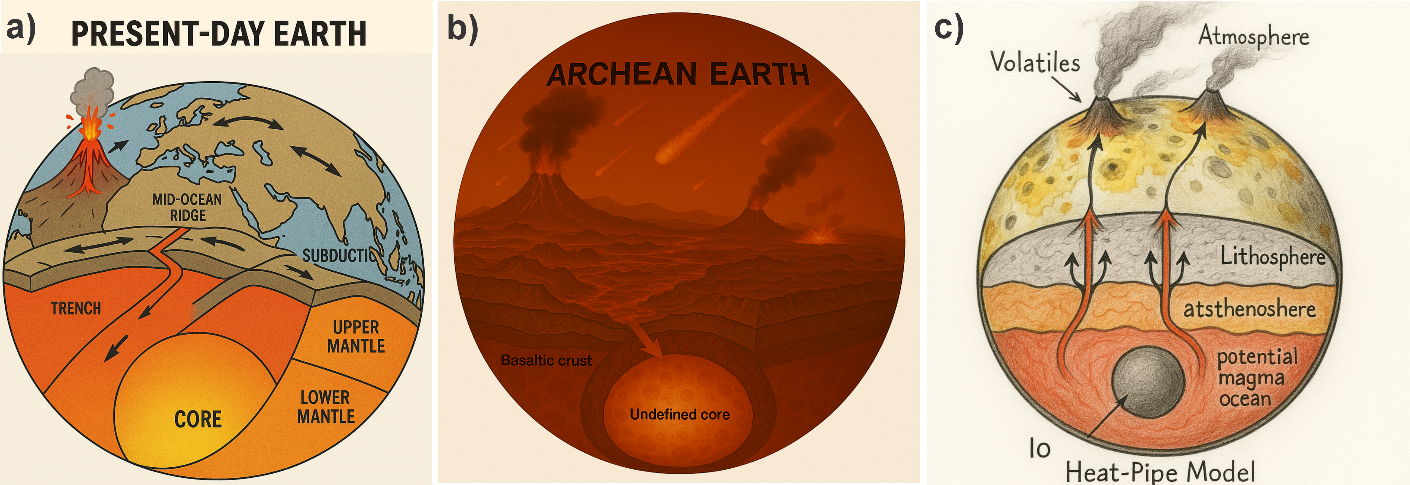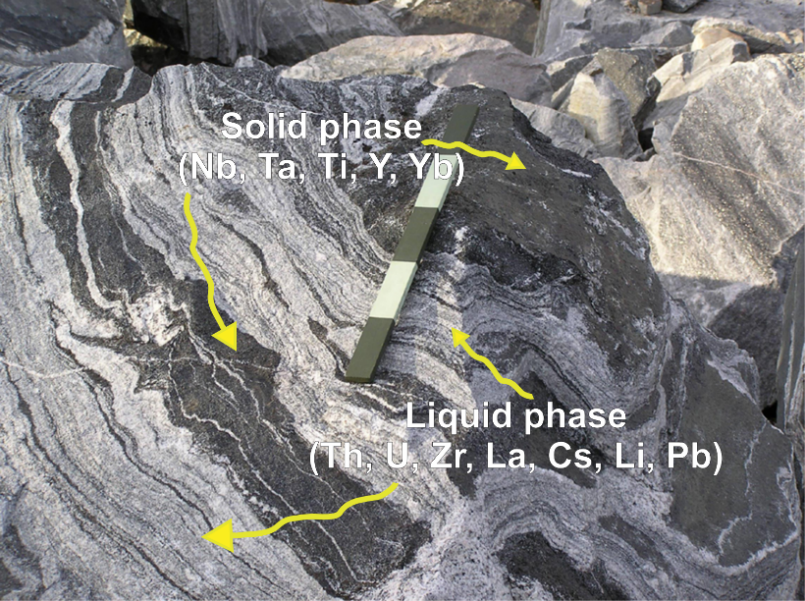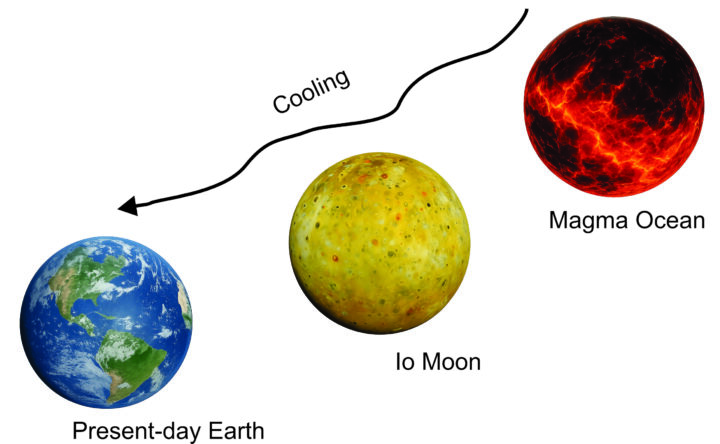From Magma Ocean to Present Earth: The origin of our continental crusts
The Earth we know today is the result of the gradual cooling of a planet-sized ball of magma. This cooling process began approximately 4.6 billion years ago and continues to this day. In its early stages, Earth’s physical state was significantly hotter and more plastic than it is now. Under such conditions, Plate Tectonics—as we understand them today—could not yet operate or dominate the planet. Understanding how and when Plate Tectonics began on Earth is essential for unraveling the processes behind the formation of the continents. Our continents are fragments of continental crust that not only support part of the biosphere but also contain many of the critical resources mined for developing green energy transition technologies.
The onset of Plate Tectonics
I have always been passionate about Plate Tectonics. Its dynamic processes built the mountains of the country where I was born. I still remember myself as a child, gazing through the window of our family car during road trips, wondering: “How do the mountains grow?” Those moments, set against the backdrop of my rural homeland, planted the seed of curiosity that led me toward Earth-related studies. There was also a familial influence in choosing this path. Some members of my family built their livelihood working for the Oil and Gas industry—savings earned through 30 years of stable and dedicated work. Still, during my B.Sc. studies, I found myself drawn—almost instantly—to inorganic geochemistry. The way chemical elements migrate through various fluid–rock interactions deeply inspired me and ultimately defined the direction of my career. The rocks from which we extract critical elements and materials for modern technologies are themselves products of Plate Tectonics. This grand geodynamic system reflects the interaction among the solid crust on which we live, the viscoelastic interior of the Earth, and the complex processes occurring at and above the surface.
While humans can observe Earth’s surface directly, we cannot see the processes unfolding within its interior. Therefore, I have included the first image of this blog (Figure 1a). In that sketch, we see how Earth’s crust can subduct into the planet’s interior while magma rises and erupts onto the surface. Such visualizations represent one of the most important conceptual advances in Earth Sciences. Even though we cannot see the Earth’s interior, we can model it—imperfectly, but increasingly accurately. Plate Tectonics has played a crucial role in shaping our planet—not only creating continents but also contributing to the oxygenation of the atmosphere, ultimately making Earth’s surface habitable. Yet, Plate Tectonics has not always operated in the way we understand it today. One of the greatest challenges in Geosciences is to determine when this tectonic regime began. Current hypotheses suggest initiation times around 4.0, 3.8, 3.2, 2.8, 2.0, 1.8 and 1.3 billion years ago. Regardless of its exact onset, two facts remain: 1) It took billions of years for Plate Tectonics to sculpt the present-day Earth, and 2) prior to that, Earth’s interior behaved very differently.

Figure 1. a) A general scheme of present-day Plate Tectonics. b) An image of how the Earth used to look like in the Archean. c) A sketch of the Io Moon dynamics. All images in this figure were created giving commands to ChatGPT.
What was happening on Earth before the Plate Tectonics?
Figures 1b and 1c illustrate that the early Earth was essentially a planet-sized ball of magma (an analog of this magma ball could be the exoplanet 55-Cancri-E), still experiencing intense meteorite bombardment (Figure 1b). This was followed by a prolonged cooling phase during which Earth released heat and volatiles towards the atmosphere in a way similar to Io, one of Jupiter’s moons, which today operates as a Heat-Pipe planet (Figure 1c). I used to be so obsessed with Plate Tectonics that, at some point during my B.Sc., I became somewhat of a self-proclaimed expert—and that fed a foolish sense of pride. I remember going through that classic job-hunting crisis we all face at some stage in life, when my mother told me: “Dude, if you are already that pro in Plate Tectonics, why don’t you study another career or specialization? If you think you know everything already, you should learn a new profession!”. After that moment, life led me toward the Archean, the chapter of Earth’s history that predates the onset of Plate Tectonics. The Archean is more than just an Eon; it feels like an entirely different profession. The Archean is a new pathway. It is another branch, or perhaps the trunk from which all other branches fork. During the Archean, Plate Tectonics as we understand them today had not yet begun. The modern configuration of continents hosting complex life did not exist. Instead, Earth’s atmosphere was characterized by much lower levels of oxygen, and much higher concentrations of carbon dioxide and methane. The involvement of Io and 55-Cancri-E in my research reminds me that during the job-hunting crisis I realized that Planetary Geosciences must be one of the most exciting paths to pursue. Thanks to the space programs of various developed nations, planetary geoscientists can now observe real-time geological processes on other terrestrial bodies. This enables us to approximate the conditions that may have dominated early Earth, before Plate Tectonics emerged.
The uniformitarian principle in geosciences states that “the same geological laws and processes that operate today have also operated in the past”. While this principle holds true for the time span in which Plate Tectonics has been active, it becomes problematic when applied to rocks formed before Plate Tectonics existed. In other words, knowledge derived from plate tectonic processes cannot be reliably applied to rocks that originated in a tectonic-less Earth. As the Earth cooled, part of its Archean crust solidified into what we might call a lava crust. Remnants of this ancient crust can still be studied on every continent, such as in Northern Finland. The roots of these ancient crustal fragments are metabasalts (Figure 2). The prefix meta- refers to their current state: They are metamorphic rocks, meaning they have undergone high-pressure and high-temperature conditions sometime after their formation. The term basalt- describes their composition, which closely resembles that of modern-day basalts. This compositional continuity suggests that basaltic volcanism occurred before, during, and after the onset of Plate Tectonics. Moreover, before, during, or after their metamorphism, many of these Archean metabasalts underwent a fundamental geological process known as partial melting. This process plays a central role in Earth Sciences and will be explored in the next section.
The firsts continental crusts: What do we need to partially melt a basalt?
Our continents are composed mainly of the commonly known “granite”. A granitic rock can form through partial melting of basaltic rocks. Partially melting a basalt means exposing it to high-pressure and high-temperature conditions in which the rock melts, but not completely. “Imagine a bean soup at very high pressures and temperatures”—that is how my first petrology professor described partial melting. At such conditions, basalt separates into a solid phase (the beans) and a liquid phase (the tasty soup) (Figure 2). The solid phase consists of elements that remain unmelted while the liquid phase contains elements that tend to migrate away from the solid (Figure 2). When a basalt partially melts, it forms a dark-mineral-rich solid and a light-mineral-rich liquid (Figure 2). In the Archean, the lower basaltic crust experienced partial melting, and its light liquid phase represents the first “granite” recognized in continental crust (Figure 2). This Archean felsic component is called TTG—short for tonalite–trondhjemite–granodiorite. We do not know exactly what the upper Archean crust looked like—it was likely destroyed by meteorite impacts and disrupted by later tectonics. Still, we find TTG in the lower Archean crust in all the cratons around the world (Figure 2).
Two of the most debated questions in Archean tectonics are: How did this lower crust reach partial melting conditions?, and what pressure–temperature path did these basalts follow?. In spite of the fact that answering these ones is complex and highly scientific—too much for this blog—, I can explain the basic ingredients needed to partially melt a basalt: Pressure, temperature, and water. Modern Plate Tectonics can transport basalts deep into Earth where it heats up and melts. Plate Tectonics also brings water down into Earth’s interior. Nonetheless, Archean tectonics likely worked differently, so what mechanism could have brought basalts to such extreme conditions back then? And where did the water come from to form TTGs? These are central questions in my PhD research. When basalt partially melts, some critical elements stay in the solid phase—like Nb, Ta, Ti, Y, and Yb—while others enter the melt—like Th, U, Zr, La, Cs, Li, and Pb (Figure 2).

Figure 2. A TTG suite found at the Inari Lake area, exhibiting its dark (metabasalt) and light components (“granite”). This picture was taken by my second supervisor some years ago.
Fluids in Early Earth
For this final section, let us shift from using the word water to fluids. Geological fluids are complex mixtures composed of water, dissolved minerals, salts, and non-polar gases. I remember that during the fieldwork practices of my B.Sc., we often encountered basalts altered by fluid activity. In the field, signs of this activity included quartz and sulfide veins, secondary clay mineral growth, and changes in rock porosity. The common explanation for these textures, repeated endlessly by my colleagues, was simply: “Activity of hydrothermal fluids, activity of hydrothermal fluids, activity of hydrothermal fluids…”. Many of my classmates were drawn to geochemistry, but fewer were curious about the physicochemical behavior of fluids in Earth systems. That curiosity led me to pursue an M.Sc. focused on fluid–rock interaction—an opportunity made possible thanks to the generous support of my family.
During that M.Sc., I met a professor who was an expert in geological fluids. I still remember his words: “Many people come to Freiburg asking for laboratory facilities, analytical techniques, mass spectrometers, but the only tools we have in our institute are our brains. If you want to be one of the bests of the world, you must engage with the bests of the world”. This professor taught me the most up-to-date understanding of how fluids behave and how they influence Plate Tectonics. On the last 2.5 billion years, interactions between fluids and plate tectonic processes have controlled the redox state of the atmosphere, generated most of the metal deposits we depend on for modern technologies, and played crucial roles in earthquakes and volcanism. In my home country, farmers resisting mining operations often cite the phrase: “Water is life, gold is not” while driving large SUVs.
In any case, the behavior of fluids in the Archean Earth remains poorly understood. During the Earth’s formation, the accretion of meteorites and planetary debris may have delivered fluid phases deep into the planet—even into its core. As the Earth cooled, those fluids likely migrated upward toward the crust and were eventually expelled into the early atmosphere. A modern analog of this process is seen on Io (Figure 1c). Io’s volcanic eruptions can eject gas columns up to 300 km height—evidence of explosive volcanism driven by fluids, yet unrelated to any form of Plate Tectonics (Figure 1c). To trace the onset of Plate Tectonics on Earth, geoscientists analyze the chemical composition of basaltic rocks, searching for enrichments in elements known to be transported by fluids. Some Archean basalts around the world contain what is called a “geochemical subduction signature.” This suggests they were formed by partial melting of Earth’s interior—initiated by the sinking of fluids, possibly via early forms of Plate Tectonics. This “geochemical subduction signature” is one of the most important tools for determining when Plate Tectonics began. Identifying, analyzing, and describing this signal in Archean basalts is another key goal of my doctoral research. To achieve the goals of my work, I must constrain the nature of fluids on the Archean Earth. By answering the questions posed in this blog, I hope to shed light on how Plate Tectonics began, how our continents were born, and how critical elements migrated from Earth’s deep interior into the ore deposits we now rely on to build a more sustainable future.
Follow Marco on ResearchGate and LinkedIn!
 Funded by the European Union. Views and opinions expressed are however those of the author(s) only and do not necessarily reflect those of the European Union or European Research Executive Agency (REA). Neither the European Union nor REA can be held responsible for them.
Funded by the European Union. Views and opinions expressed are however those of the author(s) only and do not necessarily reflect those of the European Union or European Research Executive Agency (REA). Neither the European Union nor REA can be held responsible for them.
